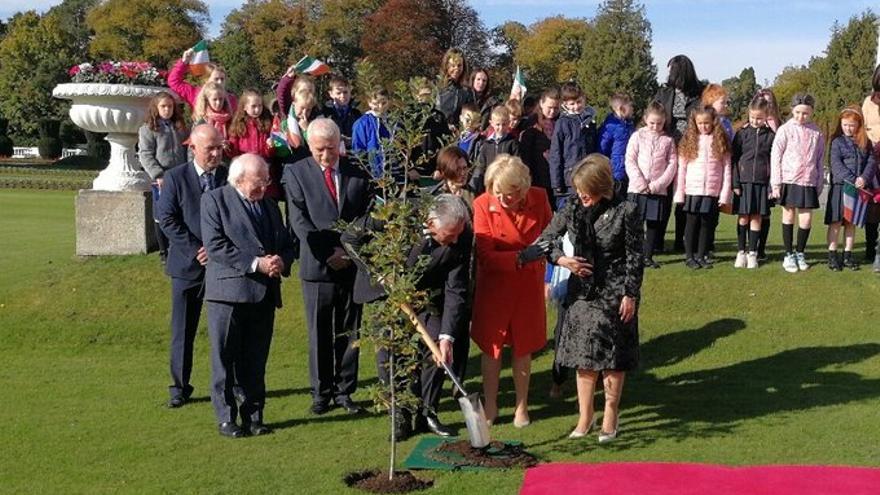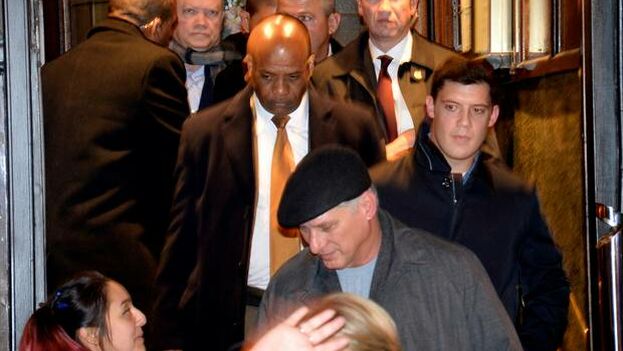
![]() 14ymedio, Havana, October 21, 2019 — The European tour of President Miguel Díaz-Canel has a stop in the western part of the continent, a rarity on the trip that the leader will take to Russia, Belarus, and Azerbaijan before attending the XVIII Summit of the Non-Aligned Movement (NAM), which will take place in Baku on October 25-26. Díaz-Canel and his wife landed this Sunday in Dublin for a three-day visit to Ireland, a country with which Cuba established diplomatic relations twenty years ago yesterday.
14ymedio, Havana, October 21, 2019 — The European tour of President Miguel Díaz-Canel has a stop in the western part of the continent, a rarity on the trip that the leader will take to Russia, Belarus, and Azerbaijan before attending the XVIII Summit of the Non-Aligned Movement (NAM), which will take place in Baku on October 25-26. Díaz-Canel and his wife landed this Sunday in Dublin for a three-day visit to Ireland, a country with which Cuba established diplomatic relations twenty years ago yesterday.
This is the first official visit of a Cuban president to Ireland, which thus returns the one made two years ago by the head of state, Michael D. Higgins, to the Island. This morning he received Díaz-Canel in Áras an Uachtaráin (the official residence of the Irish president) with the Cuban national anthem sounding in a welcome ceremony during which the Cuban planted an oak tree in the palace gardens, an act considered a symbol of friendship on the European island.
“We return to green and patriotic Ireland, that of Che’s ancestors, that which accompanied Félix Varela, that which Martí discovered, that which earned Fidel’s admiration,” said Díaz-Canel at the event.
In 2016, after the death of Fidel Castro, Higgins was the lead in a controversy over describing the ex-leader as “a giant among global leaders whose view was not only one of freedom for his people but for all of the oppressed and excluded peoples on the planet.”
Leo Eric Varadkar, who as prime minister exercises the real power in Ireland, will today receive Díaz-Canel in a courtesy visit. Also this Monday, the leader will visit the old prison of Kilmainham and will meet with Cubans living in Ireland and Irish people close to the Cuban government.
On Sunday, Díaz-Canel and his wife were received by Emma Madigan when they arrived in Dublin. The presidential entourage was completed by the ministers of Foreign Relations and Foreign Commerce and Investment, Bruno Rodríguez Parrilla and Rodrigo Malmierca. The Cuban leader traveled around St. Stephen’s Green led by Brian Glynn, director of the Americas at the Irish Ministry of Foreign Affairs.
“Ireland and Cuba are two islands united by friendship,” affirmed the diplomat, who emphasized his country’s support of Cuba against the blockade of the US and for the “update” process of Cuba’s economic model. The two countries signed an agreement on political dialogue in 2015 and have several commercial agreements.
Díaz-Canel also took advantage of the tourist trip on Sunday to go to Trinity College, whose library opened its doors to show the Cuban leader the Book of Kells (one of the most important medieval manuscripts in the world) and the more than six million other tomes that it houses, explained by Patrick Prendergast, the institution’s rector.
The Cuban president highlighted, in writing, in the visitors’ book: “The sentiment of independence and the patriotic Irish feeling, which so much unites us as peoples and as islands that we share the same sea of fights, hopes, and future.”
The Catholic Church also received Díaz-Canel, who went to the cathedral of St. Patrick, patron saint of the nation, where the reverend William Morton took him on a guided tour of the building and its relics.

The day ended for Díaz-Canel in O’Neill’s pub, on Suffolk Street, where he was able to have a pint of Guinness, the country’s most famous beer.
Neither Fidel nor Raúl Castro ever visited Ireland, although the former did make a stop in the Dublin airport in 1982 and left a gift (a box of Havanas) for then-Prime Minister Charles J. Haughey, who wrote him a thank you letter.
Two years ago, the Irish Post Office released a stamp with the image of Ernesto “Che” Guevara to commemorate the 50th anniversary of his death and recall his Irish roots. The idea generated a forceful controversy between defenders and critics of the decision and the Ministry of Communications had to clarify that the measure was taken in 2015 after following the normal procedures.
“The subject matter of the drawings of the stamps is presented to the Government in advance,” added an official spokesperson to overcome the criticisms.
Weeks earlier, the national airline Aer Lingus found itself obligated to remove ads containing images of several personalities, among them Che, from Miami International Airport.
Translated by: Sheilagh Herrera
_________________
The 14ymedio team is committed to practicing serious journalism that reflects Cuba’s reality in all its depth. Thank you for joining us on this long journey. We invite you to continue supporting us by now becoming a member of 14ymedio. Together we can continue transforming journalism in Cuba.
